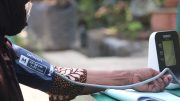HealthTech: Moving Healthcare from Mid-20th Century to Mid-21st Century
Our healthcare systems are still largely the way they were 70 years ago. Our understanding of the human body and disease may have come on in leaps and bounds but the way we treat patients remains reactive and compartmentalised rather than preventative and connected – how it should be. Fortunately, new health care technologies are rapidly changing this.
From AI to mobile apps, to robots and better user interfaces, tech is driving innovation in healthcare. And it’s not only revolutionising healthcare processes. It is also transforming our cultural narrative around health from one where doctors treat patients once they have a problem, to one where patients and doctors are equal partners in a constant conversation about patient health, with the ultimate aim of maintaining good health and preventing illnesses from ever arising. In an era where chronic disease and old-age care dominate healthcare spending, this narrative change is essential to empowering people to take control of their own health and that of their close relatives.
HealthTech Leading the Patient-led Healthcare Revolution
The rise of wellness trends and self-care in recent years is not a one-off fad, it is the beginning of a new era of healthcare, one where the patient-doctor relationship is turned on its head. This is not exactly new: the invention of the world wide web by Tim Berners-Lee in 1989 was the beginning of people sharing their healthcare experiences globally. Today, there is a seemingly endless amount of health data online, with literally millions of people exchanging advice – with differing levels of scientific accuracy – on alternative treatments and recommended healthcare providers, among other information. In this context, the rise of remote health monitoring via wearables and smartphone apps was the natural next step and it is only further fuelling patient empowerment.
One great example is the rise of women’s reproductive healthcare tracking apps that have emerged in recent years: Clue, Natural Cycles, and Fitbit’s Female Health Tracking. Such apps are allowing women to monitor and analyse their reproductive health so that they can address any health issues with their provider from an informed and empowered position. Another example is the rise in home health testing. Apps like Diagnost are increasingly allowing people to carry out their own tests for indicators like hormonal levels and receive the results in the app as well, all from the comfort of their own home. All of this self-testing only helps physicians to do their job, giving them more information with which to make diagnoses and referrals. Here, as with all recent technological disruptions, technology appears to be both producer and produced: both a stimulus for changes in the healthcare system and also a response to peoples’ desire for greater control over their own healthcare that the internet was already facilitating. Some national healthcare systems are responding to this patient-led shift in healthcare; for instance, the UK’s National Health Service has begun to offer at-home STI testing that you can order online and virtual GP visits via the app Babylon, both in London.
AI, Machine Learning and the Medical Internet of Things Creating Connected, Seamless Healthcare
The current healthcare system is fragmented, inefficient and bureaucratic – both culturally and digitally. What is more, compared to other industries, inefficient health care directly costs lives and significantly lowers quality of life for those with chronic conditions. If you have a hormonal disorder that also affects your brain and heart, for example, you may have to see three different specialists and, potentially, none of them will communicate with each other. This makes treating the human body and its illnesses holistically almost impossible. And this is still the case even after trillions of investment in Electronic Health Records (EHS). Emerging HealthTech solutions are providing some solutions, however.
Doctors have been gathering data about patients’ ailments and histories since the beginning of medicine, but the tools we now have are able to create more connected, holistic and seamless healthcare. The Medical Internet of Things is allowing data from digital health technologies like sensors, wearables, apps and genomic data to be integrated with EHS and other healthcare systems under one roof – both literally (within one hospital, for instance) and figuratively, within one digital platform or interface. Combined with intelligent software powered by AI and machine learning, this Medical Internet of Things is allowing masses of collated healthcare data to be measured, processed and analysed automatically. Using AI and machine learning algorithms to analyse healthcare data will mean that such software can pinpoint the most urgent problems presenting in patients and give real-time insights, helping to guide physicians as to the most effective course of action. For instance, it is likely that AI software will soon be used go through scans, like brain scans, to pick out anomalies, freeing up professionals like radiologists to focus on diagnosis and research instead.
Let me paint a picture of what all of the above could look like: you go to your GP, and they use a portable tablet ultrasound to make a quick scan of your ovaries, the results (if anomalous) are sent to a gynaecologist and an endocrinologist immediately, who can discuss with each other virtually and set up an appointments to arrange a joint care plan then and there. No need for bureaucratic referrals or months waiting for intermediate appointments. This enables your GP to fulfil the role they should be doing: managing your healthcare in the most personalised, holistic, and effective way possible.
Challenges Remain to HealthTech but the Potentiality for Improvement is Huge
Of course, major challenges continue to impede the implementation of breakthrough healthcare technologies. Certain healthcare systems face huge bureaucracy and funding mountains to climb before being able to introduce such new tech across the whole national system, for instance. In some cases, healthcare practitioners themselves resist the deployment of new technologies, like robotics and AI, that they fear may replace them. In others, data standardization and security processes block quick tech deployment; standardising data formats across different healthcare software systems and protecting sensitive healthcare data are incredibly important but also complicated, lengthy and often ongoing processes, after all.
Ultimately, though, it will be impossible to resist the HealthTech revolution as we move into the 2020s. Patients are simply too hungry for healthcare transformation – and they will make the change themselves if healthcare systems don’t do it first. What’s more, with ageing populations in most of the developed world already a major burden on public health care budgets and life expectancy only increasing, leveraging new technologies is no longer just a nice extra. It’s now an urgent necessity for countries who need to maintain high health care standards while simultaneously lowering costs. The UK is a prominent example but it’s far from being alone in facing a health care funding crisis driven by the rising costs of elderly and chronic-disease care.
HealthTech is not only bringing about more personalised, easy-to-use and seamless healthcare systems but actually revolutionising the whole way we perceive healthcare and how we treat our own bodies. How this emerging tech will be used in healthcare – and what kind of new innovations may arise – will be rapidly revealed as we move into the 2020s.
About the author: Tatiana Bakunina
London School of Economics and Harvard graduate Tatiana has more than 20 years’ experience in the field of medical innovations development including high-tech medical equipment, medicines and methods of modern diagnosis and prevention of diseases. She was VP for medical innovation and acquisition of new companies at Johnson & Johnson Medical Corporation in the European Headquarters in Belgium. She founded Quale Vita Group in 2011 and in 2019 she launched the health boutique Aloft and the healthtech company Diagnost.





